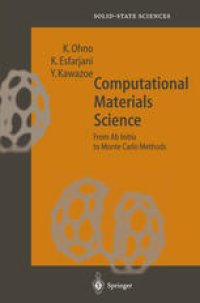
Ebook: Computational Materials Science: From Ab Initio to Monte Carlo Methods
- Tags: Theoretical Mathematical and Computational Physics, Condensed Matter Physics, Numerical and Computational Physics, Characterization and Evaluation of Materials
- Series: Springer Series in Solid-State Sciences 129
- Year: 1999
- Publisher: Springer-Verlag Berlin Heidelberg
- Edition: 1
- Language: English
- pdf
This book introduces modern techniques based on computer simulation to study materials science. It starts from first principles calculations that enable the physical and chemical properties to be revealed by solving a many-body Schroedinger equation with Coulomb forces. For the exchange-correlation term, the local density approximation is usually applied. After the introduction of the first principles treatment, tight-binding and classical potential methods are briefly introduced to indicate how one can increase the number of atoms in the system. In the second half of the book, Monte Carlo simulation is discussed in detail. Readers can gain sufficient knowledge to begin theoretical studies in modern materials research.
This book introduces modern techniques based on computer simulation to study materials science. It starts from first principles calculations that enable the physical and chemical properties to be revealed by solving a many-body Schroedinger equation with Coulomb forces. For the exchange-correlation term, the local density approximation is usually applied. After the introduction of the first principles treatment, tight-binding and classical potential methods are briefly introduced to indicate how one can increase the number of atoms in the system. In the second half of the book, Monte Carlo simulation is discussed in detail. Readers can gain sufficient knowledge to begin theoretical studies in modern materials research.
This book introduces modern techniques based on computer simulation to study materials science. It starts from first principles calculations that enable the physical and chemical properties to be revealed by solving a many-body Schroedinger equation with Coulomb forces. For the exchange-correlation term, the local density approximation is usually applied. After the introduction of the first principles treatment, tight-binding and classical potential methods are briefly introduced to indicate how one can increase the number of atoms in the system. In the second half of the book, Monte Carlo simulation is discussed in detail. Readers can gain sufficient knowledge to begin theoretical studies in modern materials research.
Content:
Front Matter....Pages I-X
Introduction....Pages 1-5
Ab Initio Methods....Pages 7-138
Tight-Binding Methods....Pages 139-170
Empirical Methods and Coarse-Graining....Pages 171-194
Monte Carlo Methods....Pages 195-270
Quantum Monte Carlo (QMC) Methods....Pages 271-283
Back Matter....Pages 285-325
This book introduces modern techniques based on computer simulation to study materials science. It starts from first principles calculations that enable the physical and chemical properties to be revealed by solving a many-body Schroedinger equation with Coulomb forces. For the exchange-correlation term, the local density approximation is usually applied. After the introduction of the first principles treatment, tight-binding and classical potential methods are briefly introduced to indicate how one can increase the number of atoms in the system. In the second half of the book, Monte Carlo simulation is discussed in detail. Readers can gain sufficient knowledge to begin theoretical studies in modern materials research.
Content:
Front Matter....Pages I-X
Introduction....Pages 1-5
Ab Initio Methods....Pages 7-138
Tight-Binding Methods....Pages 139-170
Empirical Methods and Coarse-Graining....Pages 171-194
Monte Carlo Methods....Pages 195-270
Quantum Monte Carlo (QMC) Methods....Pages 271-283
Back Matter....Pages 285-325
....
Download the book Computational Materials Science: From Ab Initio to Monte Carlo Methods for free or read online
Continue reading on any device:

Last viewed books
Related books
{related-news}
Comments (0)